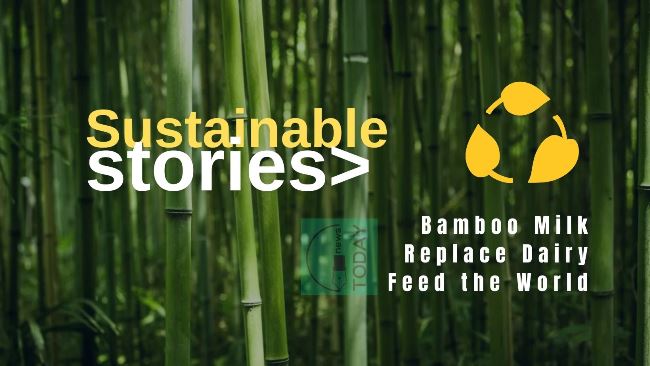Bamboo Milk: A Sustainable Dairy Alternative to Feed the World
Bamboo: A Sustainable Crop for the Future! Could Tackle Global Food Insecurity!

As the global population rises and concerns around environmental sustainability grow, the search for dairy alternatives has taken center stage. Bamboo milk, lesser-known but promising plant-based milk, is capturing attention for its potential to become a nutritious, eco-friendly alternative to cow’s milk. With bamboo’s fast growth, low resource demands, and nutrient-rich profile, bamboo milk could play a significant role in future food security, offering a sustainable solution for feeding the world.
What is Bamboo Milk?
Bamboo milk is derived from the leaves and shoots of the bamboo plant, which are soaked, blended, and then filtered to create a smooth, drinkable liquid. Unlike traditional dairy or even other plant-based milks, bamboo milk has a unique flavor that’s often described as mild and slightly nutty, making it a versatile option for drinking plain or adding to coffee, smoothies, and various recipes.
Nutritional Benefits of Bamboo Milk
One of the most compelling aspects of bamboo milk is its nutritional profile. Bamboo is naturally rich in silica, which is essential for skin, hair, and bone health. It also contains vitamins B and C, along with antioxidants that help combat oxidative stress in the body. While bamboo milk may need to be fortified with calcium, vitamin D, and B12 to match dairy in certain areas, its naturally low fat and calorie content make it an attractive option for those seeking lighter, healthier milk.
Bamboo: A Sustainable Crop for the Future
Bamboo’s environmental benefits are significant. Unlike many traditional crops, bamboo requires minimal water, grows quickly, and doesn’t rely on chemical fertilizers or pesticides. Its rapid growth rate means it can be harvested sustainably without deforestation, regenerating itself after being cut. Compared to almond or soy farming, which requires large amounts of water or can lead to deforestation, bamboo farming is gentler on the planet. This efficiency could make bamboo milk production more scalable and affordable over time, reducing its carbon footprint and helping to curb greenhouse gas emissions.
How Bamboo Milk Could Tackle Global Food Insecurity
As the demand for food continues to increase, traditional dairy farming may struggle to meet the needs of a growing population, particularly with its heavy water and land demands. Bamboo milk offers an alternative that could ease the burden on resources while providing a nutritious option for people in regions with limited access to dairy. Bamboo is capable of thriving in diverse climates, from tropical to temperate regions, making it feasible for cultivation in many parts of the world, including areas where traditional dairy farming is not viable.
The Challenges and Future of Bamboo Milk
Despite its promise, bamboo milk is still a relatively new entrant in the market and has some challenges to overcome. Currently, there are limited producers, and scaling up bamboo milk production will require investment in processing facilities and supply chains. Additionally, consumer awareness and acceptance are hurdles that plant-based milk companies will need to address through education and marketing.
Innovation within the plant-based food industry, however, has proven that with the right support and consumer interest, new foods can grow rapidly in popularity. Like almond, soy, and oat milks, bamboo milk could become a mainstream option as production expands and demand increases for sustainable alternatives.
Bamboo Milk’s Place in the Future of Food
Bamboo milk’s unique combination of nutritional benefits, environmental sustainability, and scalability makes it a strong candidate to join the ranks of popular plant-based milk options. By reducing dependency on resource-intensive dairy farming, bamboo milk has the potential to contribute to a more sustainable, resilient food system, one that could help meet the needs of a growing global population while respecting the planet’s resources.
With ongoing research, innovation, and consumer support, bamboo milk could very well play a transformative role in the future of food. As we seek new ways to address environmental and nutritional challenges, bamboo milk stands as a promising option, holding the potential to nourish both people and the planet.
Where can we find Bamboo Milk?
Bamboo milk is still relatively new and not yet widely available on the shelves of most grocery stores. However, you may be able to find it in specialty health food stores or order it from online retailers that focus on plant-based and niche food products. Some options for sourcing bamboo milk include:
- Online Marketplaces: Websites like Amazon and specialty health food sites may carry bamboo milk or bamboo milk powder.
- Health Food Stores: Certain health food and organic stores may carry bamboo milk, especially those that stock a diverse range of plant-based milks.
- Asian Grocery Stores: In some Asian countries where bamboo is more commonly used in food, certain stores may carry bamboo-based beverages.
- Direct from Manufacturers: Some smaller brands or niche companies producing bamboo milk may sell it directly on their own websites, offering shipping options to various regions.
- Powdered Form: Bamboo milk powder is sometimes easier to find than fresh or bottled bamboo milk. You can mix it with water to create bamboo milk at home.
Since bamboo milk is still emerging, availability might be limited depending on your location, but its growing popularity means more retailers may begin to carry it soon.
Bamboo: The Fast-Growing, Sustainable Super plant with Potential to Revolutionize Food Production
Bamboo, which already covers nearly 3% of China’s forest area, is one of the most common plants in the wild. It’s used for food and many other purposes, but fully harvesting its shoots could increase production by an estimated 150 million tonnes. As a type of grass, bamboo regrows rapidly after harvest, making it a sustainable resource. According to BBC Science Focus, bamboo is the fastest-growing plant on Earth, capable of growing almost a meter in a single day and requires minimal resources to thrive.
How to process Bamboo Milk?
Making bamboo milk is a simple process, especially if you have access to bamboo leaves or shoots. Here’s a basic guide to help you prepare bamboo milk at home:
Ingredients
- Fresh bamboo leaves or young bamboo shoots (around 1–2 cups)
- Filtered water (4 cups)
- Optional: sweetener (like honey, agave, or sugar) and a pinch of salt
- Optional: vanilla extract or other flavors
Instructions
- Prepare the Bamboo:
- If using bamboo shoots, cut them into small pieces for easier blending. If using bamboo leaves, rinse them thoroughly to remove any dirt or impurities.
- Boil the Bamboo:
- Place the bamboo pieces or leaves in a pot with about 4 cups of filtered water.
- Bring the water to a boil, then reduce to a simmer and cook for about 15–20 minutes. This will soften the bamboo and release its nutrients.
- Cool and Blend:
- Let the boiled bamboo and water cool down to a manageable temperature.
- Pour everything (including the water) into a blender and blend on high until the mixture is smooth. If you like, add a natural sweetener or a pinch of salt to enhance the flavor.
- Strain the Mixture:
- Use a fine-mesh strainer or cheesecloth to strain the mixture into a bowl or pitcher, removing any pulp or fibrous parts. This step will give you a smoother, milk-like consistency.
- Adjust Flavor (Optional):
- Add a drop of vanilla extract or another flavor enhancer if desired, and stir to combine.
- Store and Serve:
- Pour the bamboo milk into a clean, airtight container and refrigerate. It should last for 3–4 days.
- Shake before serving, as natural separation may occur.
Tips
- Dilution: If the milk is too thick, add more water until you reach your desired consistency.
- Nutritional Boost: You can also add a small amount of plant-based calcium powder or other nutritional boosters for added benefits.
Bamboo milk prepared this way can be enjoyed on its own, added to coffee, smoothies, or used in recipes as a dairy substitute.
Bamboo’s potential as a sustainable food source is immense, driven by its rapid growth, widespread availability, and low resource demands. As a highly renewable resource, bamboo offers a practical solution to global food challenges, producing an abundance of biomass without the environmental strain that traditional agriculture often entails. Beyond its nutritional value, bamboo’s resilience and minimal environmental footprint align with global sustainability goals, making it an ideal candidate for future food and material innovations. If embraced more widely for consumption, bamboo could contribute significantly to food security, especially in regions where arable land and water resources are limited. As research and development continue, bamboo may very well become a staple in sustainable diets and eco-friendly products worldwide, demonstrating nature’s ability to provide solutions for a growing global population.
Don’t Miss Out:
Have you considered the healthiness of your Toothpaste?
For more consumer-based stories like this, read:
Don’t Listen To Rumors. Verify The Authenticity Of Any Information.
Health Benefits of Rice and Its Side Effects




